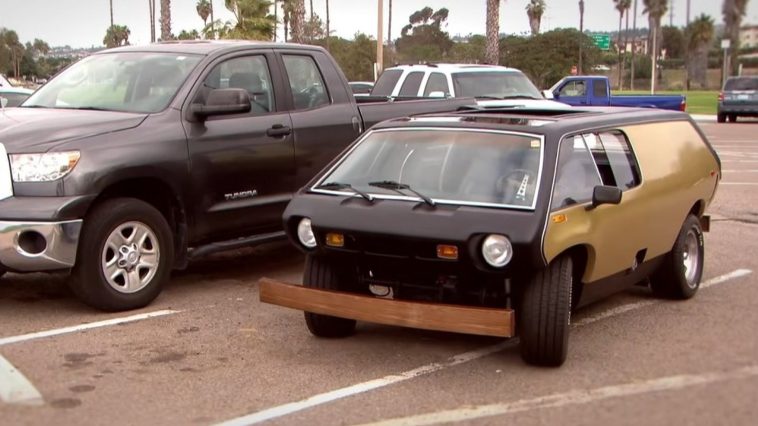Volkswagen recently unveiled the 2025 ID. Buzz, a reincarnation of its iconic hippie van. To commemorate the occasion, we thought we’d take a trip back in time to check out another cool ride that likely has been forgotten since its heyday in the 1970s. A quick glance at the Brubaker Box (also known as the Automecca Sportsvan or the Roamer) reveals similarities to Volkswagen’s new bus, and one of the many things that makes this minivan so interesting is that it was built using a bare Volkswagen Beetle chassis.
Advertisement
The Box was the brainchild of Curtis Brubaker, who you might not know of despite his long list of creations and innovations. Brubaker studied car styling at Pasadena’s Art Center College of Design, was part of the design team at Lear Jet, then moved on to work at General Motors in the advanced research group. While working at Lear, he helped design the 8-track tape player with owner/founder Bill Lear, who wanted to create a sealed cassette that never needed to be rewound.
As it turns out, that was just the tip of the proverbial iceberg for this design wizard. Brubaker had a hand in dozens of other technological advancements, including the navigational touch screen, haptic display systems, the holographic heads-up display (HUD), e-books, DUI lockouts, and many more. In 1969, Brubaker left his gig with GM and started his own design and automotive consulting company in Los Angeles.
Advertisement
A stolen van led to Brubaker’s creation
One day while in a meeting, Brubaker gazed out a window and saw his brother’s VW van rolling down Pico Boulevard. No, the parking brake hadn’t failed; it had been stolen. Brubaker took a ride to Newport Beach and discovered street after street lined with similar VWs. Struck with inspiration after realizing the vans were popular with the surfer crowd, he decided to craft a vehicle that would appeal to a younger demographic.
Advertisement
Brubaker and fellow designers Todd Gerstenberger and Harry Wykes came up with a rather odd yet revolutionary “one-box” van design featuring a singular sliding door on the passenger side, feeling that fewer doors made the fiberglass body more rigid.
The shell was built using 13 fiberglass panels riveted and bonded together, then mounted on a tube frame and attached to the chassis of a VW Beetle. The Beetle had been on the U.S. market since 1949, but by this point it was beginning to fade from its peak as an automotive icon.
To keep costs down, Brubaker and his gang took the windshield from an AMC Hornet and the rear glass from a Chevrolet El Camino, angling them to enhance the sleek appearance and give it a touch more room. Contrary to popular belief, the unique shock-absorbing telescopic bumpers weren’t made from wood. Instead, they were fiberglass finished with faux woodgrain.
Advertisement
Features included sofa seating in back and a frunk for storage
Primary seating was in the form of two front buckets, andrear configurations included a wrap-around couch that could be removed for added cargo space. The Box also featured a removable roof and a space in front meant to act like a “frunk” (front trunk) accessible from the inside. An in-dash ice chest/storage box was also optional, but only one vehicle is known to have included it. The entire vehicle only stood 53 inches tall. In March 1972, the Brubaker Box was featured on the cover of Car and Driver, and it debuted at the Los Angeles Auto Show the same year.
Advertisement
It was so well received that Brubaker managed to raise $160,000 (roughly $1.5 million today) from investors. This allowed him to lease a 17,000-square-foot factory. Brubaker and his team figured they could build five Boxes a month at a cost of $3,995 (equivalent to approximately $29,000 today), with the goal of increasing production to 400 per month. Brubaker’s initial plans hinged on using a Type I Beetle chassis, engine, and transmission from VW. Unfortunately, the German automaker said no, pointing to liability issues as to why it couldn’t (or wouldn’t) sell them stripped down chassis. Their only option then was to buy a much more expensive fully built Beetle, remove the body, and sell the leftovers. They did so for a brief stint, but their so-called business model wasn’t sustainable.
Advertisement
Not many people got into the Brubaker Box
Ultimately, Brubaker’s company only managed to build three Boxes before running out of investment money and going bankrupt. Brubaker sold the design to Mike Hansen (one of the company’s original investors) in Chatsworth, California, who built another 25 as the Automecca Roamer Sports Van.
Advertisement
It’s unclear how many of those 28 still exist today. One source says 19 are still floating around, while another claims only 10 remain in working condition. We do know that one of the three built by Brubaker (shown above) sits in the Petersen Automotive Museum.
If the design — which some argue is the first minivan — looks vaguely familiar, then perhaps you saw it on the popular television show “Ark II,” in the 1973 film “Soylent Green” starring Charlton Heston, or in the 1995 film “Grid Runners.” In 2019, entrepreneurs Tomo Bullum and Dale Davis tried bringing the Box back as a limited production vehicle, but their crowd sourcing campaign failed to reach its funding goal, and the project never happened.
Advertisement
The extreme rarity of the Brubaker Box makes it hard to pin down its value, although we have one helpful point of reference. In July of 2023, one of the 25 Automecca models appeared on eBay and sold for $68,900. If you are still interested in one despite that price tag, there may be hope. According to a video from the Petersen Automotive Museum, someone bought the rights to the Box and will soon be producing kits.




GIPHY App Key not set. Please check settings